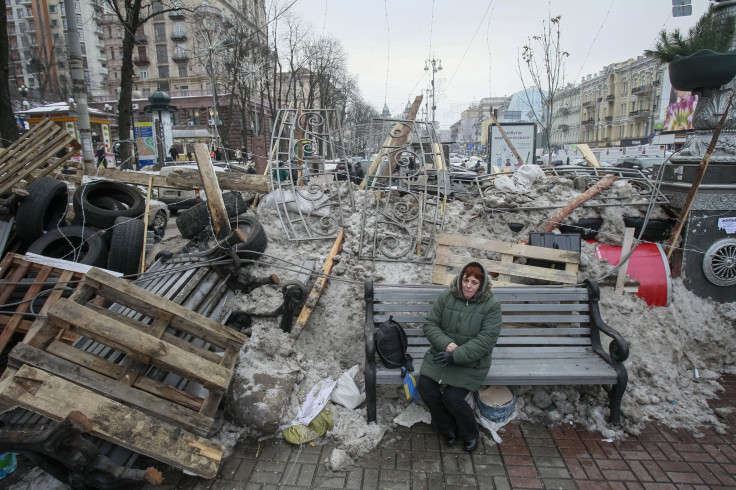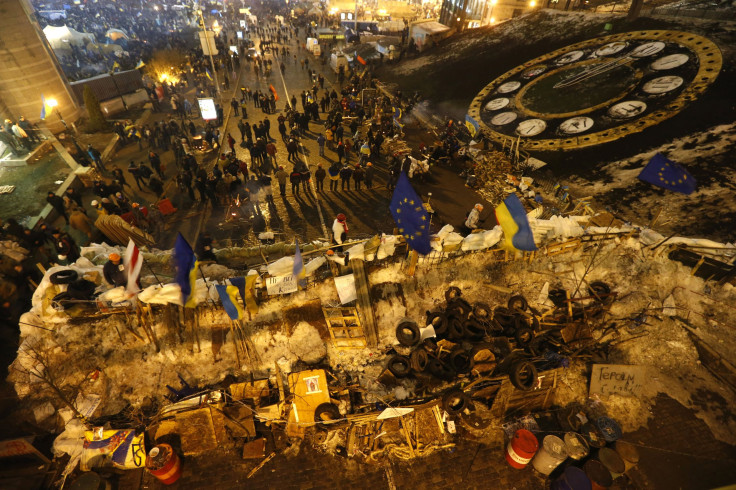Ukraine's EuroMaidan: How The Kiev Protests Reflect Ukraine’s Dance Between East And West

In the early hours of Wednesday, Dec. 11, Ukraine’s riot police, known as Berkut, made their way to Kiev’s center, surrounding the square that has been the center of EuroMaidan -- Ukraine’s largest protest since the 2004 Orange Revolution.
Cleverly, the protesters had come up with tactics to stave the police off. In subzero weather, they had built massive barricades out of scrap wood and metal around the square, reinforced by snow and water that turned them into fortified blocks of ice. They poured buckets of water onto the street where the Berkut might advance, to make it more slippery. They sang and danced to Ruslana, a famous Ukrainian pop singer who entertained people for nearly 10 hours that night, in an attempt to keep police away and protesters calm.
When the Berkut did begin to advance, and tore down some barricades on one side of the square, the bells of St. Michael’s church started ringing, which in ancient times signaled danger and a call to mobilization. It was then that the square, filled with smoke and covered in white snow, saw a moment of peaceful unity: Ukrainian men linked hands and created a ring, facing the police and encircling women protesters to protect them, in a “touching gesture that had no air of pretense,” wrote Katya Gorchinskaya in the KyivPost. With the air filled with tension, and the eyes of the world watching live feeds as a clash seemed inevitable, the protesters sang Ukraine’s national anthem and the “Our Father” in Ukrainian.
What was “striking is how quickly Kyiv mobilized and moved into the city center, turning a crowd of a few hundred into a mass of tens of thousands of people in a matter of several hours ... This was the massive proof that EuroMaidan is not about its leaders, that it’s truly the will of the people,” Gorchinskaya wrote.

Though there were a few clashes during those early hours of Dec. 11 that injured protesters and police members alike, the Berkut eventually retreated, packing back into their vans and driving away as the night melted into day. And as a few Ukrainian-American students of the Euromaidan Journalist Collective reported on the morning of Dec. 11, the Maidan -- which means “square” in Ukrainian -- was “back in business.”
The origins of EuroMaidan began as a much smaller protest that had sprouted in Independence Square in the center of Kiev on Nov. 21, the day Ukrainian President Viktor Yanukovych had, at the last minute, changed his mind on an Association Agreement with the European Union, deciding to strengthen economic ties with Russia instead. But it wasn’t until Nov. 30, when a group of student protesters were attacked by police leading to several injuries and hospitalizations, that the protest became a national movement. Masses swarmed to join in Independence Square, swelling up to nearly 1 million on Dec. 8.
A recent poll showed that 70 percent of the people on the Maidan were there to support the rights of Ukrainians to protest peacefully without threats of police brutality. And in the days following Nov. 30, it seems that EuroMaidan has grown into something far bigger than what it had originally started out as.
Russia’s ‘Little Brother’
Last week, protesters rushed to the site of a Lenin statue in Kiev and proceeded to knock it down and tear it to pieces. It’s difficult to say whether this was truly symbolic of EuroMaidan as a whole or if it was a moment of misplaced fury. Indeed, Ukraine has had a tumultuous -- yet closely intertwined -- relationship with neighboring Russia for centuries. Many years of domination by the enormous neighbor to the north and east are etched in the memory of Ukrainians, as well as giant-scale oppression such as the Holodomor, the man-made famine induced by Stalin in 1932-33 that left up to 8 million Ukrainians dead and was subsequently covered up by Soviet propaganda.
Ukraine has been dancing between East and West since the mid-1600s. Over the course of hundreds of years, it was dominated by and divided between Poland, Austria-Hungary and the Soviet Union until it gained independence in 1991. But Ukraine has remained intertwined with Russia economically. The eastern part of Ukraine, which is both geographically and economically closer to Russia, tends to contain more Russian speakers and those favoring an alliance between Yanukovych and Russia’s strongman president Vladimir Putin. Western Ukrainians, on the other hand, tend to lean toward the West and European integration, to speak Ukrainian rather than Russian and to consider themselves “nationalists.”
But EuroMaidan isn’t so much about a divide between East or West. Kiev is located in central Ukraine, and there are both Ukrainian speakers and Russian speakers filling Independence square, with many bilingualists speaking both.
If Moscow thinks that the protest is just the expression of a desire to move west, away from Russia, it’s mistaken. EuroMaidan moves beyond that.
“One thing [Russian politicians] do not notice is that there is a strong middle class in Ukraine that is much stronger than in Russia, and that middle class clearly puts out a voice that values are more important than assets,” Yevhen Hlibovytsky, founder at the think tank pro.mova, said at a Radio Free Europe / Radio Liberty Google Hangout discussion. “And you can’t buy these people. And they will fight and they will go as far as they have to go.” Hlibovytsky also mentioned that each successive generation in Ukraine tends to become more Western-minded, while in Russia this may not necessarily be the case.
“[F]or the Kremlin, controlling Russia’s little brother” shouldn’t be so hard, Andrey Slivka writes in The New Yorker. “As a new generation slowly takes over in Ukraine, and as demographic changes favor the country’s pro-Europe west, it will grow harder still. One would think that Putin might realize that the old way of handling Ukraine has reached a point of diminishing returns: perhaps it would be wiser, at this point, to cease putting Russia’s chips on Ukrainian thugs.”
In other words, EuroMaidan may not be about Russia as much as it is about Yanukovych’s government itself. “This is more a story about what’s happening at home [in Ukraine] than it is of perceived Russian interference with Ukraine,” Orysia Kulick, a Ph.D. candidate in history at Stanford University who lived in Ukraine during the unfolding of the Orange Revolution in 2004, told International Business Times. “This is the culture and people are just fed up of being pushed around, of feeling like they don’t have opportunities, [a feeling] that they can’t progress. They feel like [their government] has been taken over by this band of thieves.”
Stephen Sestanovich, U.S. ambassador-at-large to the former Soviet Union from 1997 to 2001 and now and a senior fellow for Russian and Eurasian studies at the Council on Foreign Relations, said in a media conference call that Ukrainians suffer from a sense of disillusionment in their politicians: They feel that all politicians are alike in their corruption, even jailed opposition leader Yulia Tymoshenko. "Leaders who've come to the fore [during EuroMaidan] -- [world champion boxer Vitali] Klitschko in particular -- they're not really riveting, charismatic people,” Sestanovich said. “They're dull, honest politicians. This is the hour for dull honesty among Ukrainian politicians."
The Face Of The Maidan
According to the Euromaidan Journalist Collective, despite freezing weather and police scares, the participants in the square find ways to keep their spirits up: They hand out tea and food, play traditional Ukrainian music like the bandura, make jokes and sing -- a lot. “During the day, it’s peaceful but passionate,” Adriana Krasniansky, a 20-year-old member of Euromaidan Journalist Collective, said. “Everyone’s ready but in good spirits.”
The Maidan is filled with older people with memories of Soviet life, but the core of the movement is made up of those born after 1991. According to a poll that surveyed about 1,000 protesters, the average age is about 36. It’s a movement largely drawing strength from people’s individual convictions, rather than political affiliation; the same poll found that 92 percent stated they didn’t belong to a particular party or organization. And EuroMaidan has been considered an “educated” movement, with 64 percent of the protesters having a university education.
The protesters have refused to leave the square until their demands are met: for the government to release jailed protesters and sign the EU agreement, and for Yanukovych to resign.
In a statement this week, U.S. Secretary of State John Kerry expressed his support for the protestors, saying the U.S. was “disgust[ed] with the decision of Ukrainian authorities to meet the peaceful protest ... with riot police, bulldozers and batons rather than with respect for democratic rights and human dignity ... As church bells ring tonight amidst the smoke in the streets of Kyiv, the United States stands with the people of Ukraine.”
What Happens Next?
On Wednesday, Yanukovych reportedly said he was still considering signing the European agreement. "He indicated he still wishes to sign the Association Agreement with the European Union," EU foreign policy chief Catherine Ashton told CNN. "From our perspective, we think that's good for this country. But the present crisis that's happening right now needs to be resolved."
Meanwhile, during his state of the union address this week, Russian President Vladimir Putin found a way to mention the unrest in Ukraine: “Even before all these [protests] which we now see in Kiev … Ukraine more than once declared its interest in joining some agreements of the customs union [with Russia, Belarus and Kazakhstan],” Putin said in his televised speech. “We are not imposing anything on anybody. If our friends have a desire for joint work we are ready to continue this work.”
Sestanovich believes Yanukovych has limited maneuvering room in his situation of being pulled between East and West. “[Yanukovych] has the promise of long-term benefits from the EU, but nothing concrete in the short-term,” Sestanovich said. “He’s got some benefits from the Russians, but he’s seeing what kind of public reaction created among the crowds. He won’t be able to solve this crisis by saying he’s got a discount on gas.” (Ukraine, like the European Union, imports vast amounts of Russian natural gas.)
As for the people on the Maidan, they don’t appear to be exhausted quite yet. Perhaps these protesters have been galvanized by Yanukovich’s snub to the EU; or perhaps they’re tired of Russian “dominance,” shouting slogans like, "Russian hands off Ukraine!" in an outburst of anti-Soviet sentiment, 22 years after the demise of the USSR. Maybe Kiev civilians rushed to the square on Nov. 30 and Dec. 11 simply as individuals with a moral compass, to protect students and women, because they oppose police brutality. Most likely, however, protesters are frustrated with the deep-rooted corruption in their own broken political system, which is something of a kleptocracy -- Ukraine ranked 144 out of 176 nations in the Corruption Perceptions index compiled by Transparency International.
Maybe it's a little of all of these things. “This [movement] is like moving toward another level of consciousness,” Kulick said. “It’s about transforming Ukraine, and it’s about asserting that its place is not Russia. It’s about taking ownership of the space and saying we absolutely do not want to live this way anymore.” She called it a profound “paradigm-shifting historical moment” that was quite different from the 2004 Orange Revolution.
It seems that young Ukrainians are, for the first time, truly passionate about taking matters into their own hands and steering Ukrainian politics in a new direction, to a more democratic and European state. It’s clear that Ukrainians are ready, and they want to be heard.
© Copyright IBTimes 2024. All rights reserved.





















